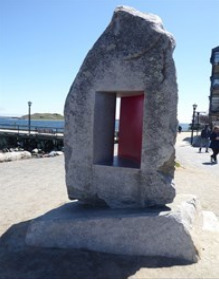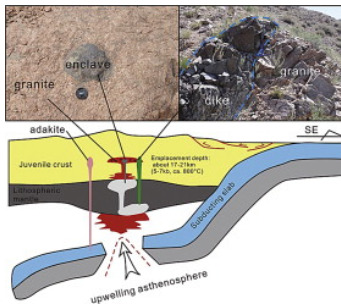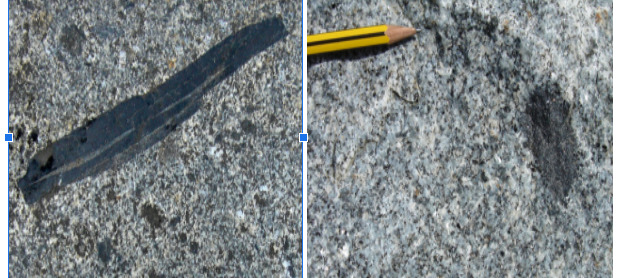Passage - An enclave lives here
Passage is a dramatic, large-scale granite sculpture by Vasilis Vasili located on the Halifax Waterfront. Thanks to OhioRider for pointing this out and helping with the earthcache.
Granite is an igneous rock, forming the bulk of the continental crust of the planet. It is a resistant material widely used in construction, paving, decoration and sculptures.

It is light-colored with grains large enough to be visible with the unaided eye. It forms from the slow crystallization of magma below Earth's surface. Granite is composed mainly of quartz and feldspar with minor amounts of mica, amphiboles, and other minerals.
Granites are like "bubbles" of magma, mixtures of molten silicates and gas, rising in the earth's crust. They gradually lose their heat and crystallize in depth a few kilometers below the surface at the time of their establishment. Cooling slowly, multi-millimeter to centimeter-scale minerals then form, meshed with each other and easily discernible with the naked eye. These "grains" visible to the naked eye give its name to the texture of granite: it is called "grainy".

The granite's sometimes show dark spots which break the homogeneity of their texture. These are called enclaves. These are actually pieces of rock embedded in the rock.
Two main types of enclaves, rather very abundant, and one can be distinguished in the Vire granodiorite:
(1) corneal enclaves: dark in color, angular, with a very fine grain, of variable centimeter to decimetric size. Their appearance is very different from that of granodiorite. They sometimes have a banded appearance and their contact with the granita is always clear. They are interpreted as being fragments of the surrounding lands encompassed and metamorphosed by the granite intrusion.
(2) overmicaceous enclaves: lenticular or ovoid in shape, centimeter to decimetric size and sometimes gneissic in texture, they are characterized by their richness in biotite and by the frequent presence of andalusite, sillimanite or corundum. They are also rocks very different from granodiorite and of foreign origin. They would represent remnants of the melting of the lower crust or fragments of deep basement brought up by the magma.

Corneal enclaves Overmicaceous enclaves
These dark enclaves, basic enclaves (the most numerous), or restored, are frequent so that the quarrymen have given them a name: "toads" . It is also the name given by jewelers to the impurities that can sometimes be seen in diamonds or other transparent precious stones.
To log this Earthcache visit the viewing location. Please answer the following questions and send in a timely manner to my geocaching profile or email. Answers not received will result in deleted logs.
1. Look at the grain in the granite and tell if it is coarse, fine, large or small?
2.An enclave can be seen on the art work . See if you can find it and describe (length, width, colour, location)? hint it is fairly small and one seen towards the bottom.
3. Can you tell by the definition if it is Corneal enclaves or Overmicaceous enclaves?
4. How many drill holes and blast holes do you see?
5.[REQUIRED] In accordance with the updated guidelines from Geocaching Headquarters published in June 2019, photos are now an acceptable logging requirement and WILL BE REQUIRED TO LOG THIS CACHE. Please provide a photo of yourself or a personal item in the picture to prove you visited the site.